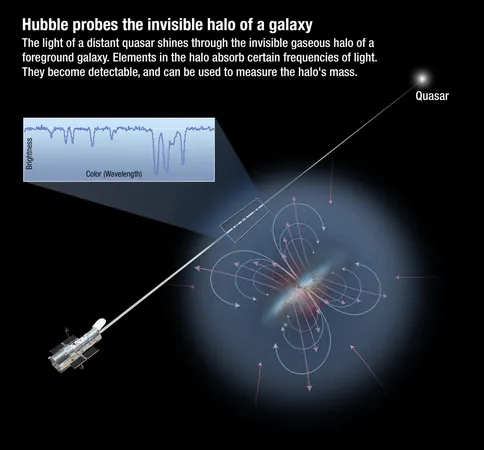
The Incredible Journey of Carbon: From Stellar Explosions to Your Body!
2025-01-07
Author: Li
The Cosmic Journey of Carbon
Have you ever considered that every atom in your body has experienced a cosmic journey? Astoundingly, the carbon in your bones was born in the heart of massive stars, forged through nuclear fusion before being flung into the vastness of space to create the building blocks of life. A groundbreaking study has shed light on this extraordinary journey, revealing some unexpected findings about how stars recycle their materials and contribute to the cosmos.
Origins of Carbon
Carbon is one of the essential elements for life, and its origins trace back to the very early universe, approximately 13.7 billion years ago, when it was primarily composed of hydrogen and helium. As stars evolved, they underwent multiple fusion reactions, converting hydrogen into helium and ultimately crafting carbon through a process known as nucleosynthesis. This intricate dance of particles requires extreme conditions—temperatures soaring to around 100 million Kelvin—where three helium-4 nuclei are artfully combined to form a single carbon-12 atom.
The Stellar Lifecycle
This process does not occur without challenges. During a star's lifetime, two opposing forces are at play: the outward thermonuclear force created by fusion and the inward pull of gravity. When stars reach a critical point in their life cycle, determined by their mass, they expel their inner material, scattering heavy elements like carbon into space, often through spectacular events such as planetary nebulae or supernovae.
Recycling Carbon in Galaxies
Recent research conducted by an international team of scientists from the United States and Canada has unveiled an astonishing new insight: the carbon atoms released from dying stars do not merely drift through the universe at random. Instead, they participate in a complex and vibrant dynamic within galaxies like our own Milky Way. These liberated atoms are swept up in colossal currents known as the circumgalactic medium, which extends into intergalactic space and facilitates the recycling of cosmic materials back into regions where new stars are born.
Discoveries through Observation
Utilizing the Cosmic Origins Spectrograph aboard the Hubble Space Telescope, the researchers meticulously analyzed the ultraviolet light emitted from nine distant quasars, studying how their light interacted with the circumgalactic medium of 11 other actively star-forming galaxies. Remarkably, one galaxy showcased carbon atoms being pulled along this galactic current at an astonishing distance of nearly 400,000 light years—around four times the diameter of our own galaxy!
Implications for Stellar Evolution
This discovery offers an exhilarating new perspective on stellar evolution. Rather than envisioning a serene voyage through space, the journey of these elements is revealed to be far more chaotic and interconnected. The implications of this research extend beyond understanding the lifecycle of stars; they also hold the key to unraveling the mysteries of galaxy formation and why certain regions of space are thriving with stars while others remain barren.
Continuing the Journey
As scientists continue to investigate the complexities of the circumgalactic medium and its role in star formation, we can expect to learn even more about the intricate tapestry of the universe and our place within it. Buckle up—this cosmic journey is only just beginning!



 Brasil (PT)
Brasil (PT)
 Canada (EN)
Canada (EN)
 Chile (ES)
Chile (ES)
 Česko (CS)
Česko (CS)
 대한민국 (KO)
대한민국 (KO)
 España (ES)
España (ES)
 France (FR)
France (FR)
 Hong Kong (EN)
Hong Kong (EN)
 Italia (IT)
Italia (IT)
 日本 (JA)
日本 (JA)
 Magyarország (HU)
Magyarország (HU)
 Norge (NO)
Norge (NO)
 Polska (PL)
Polska (PL)
 Schweiz (DE)
Schweiz (DE)
 Singapore (EN)
Singapore (EN)
 Sverige (SV)
Sverige (SV)
 Suomi (FI)
Suomi (FI)
 Türkiye (TR)
Türkiye (TR)
 الإمارات العربية المتحدة (AR)
الإمارات العربية المتحدة (AR)